International Business Strategy Case Study Analysis Report
VerifiedAdded on 2022/09/03
|12
|2735
|19
Case Study
AI Summary
This case study analysis examines the international business strategies of two companies: Dominos and Microsoft. The Dominos case study focuses on the company's successful expansion and adaptation of its business model across different countries, emphasizing its adherence to its core delivery and takeaway model while customizing product offerings based on market research and consumer preferences. The analysis explores the marketing mix variations across different countries and highlights lessons in sticking to core values and customizing offerings. The Microsoft case study examines the company's acquisition of Skype and the related financial and ethical considerations, specifically the use of cash reserves to avoid taxes. The analysis delves into the benefits to shareholders, the impact of tax rates on foreign earnings, and the ethical implications of such financial strategies, concluding that such actions may be unethical in the long run. The study utilizes international business theories, including the Ansoff Matrix and business ethics frameworks, to provide a comprehensive understanding of the companies' operations.
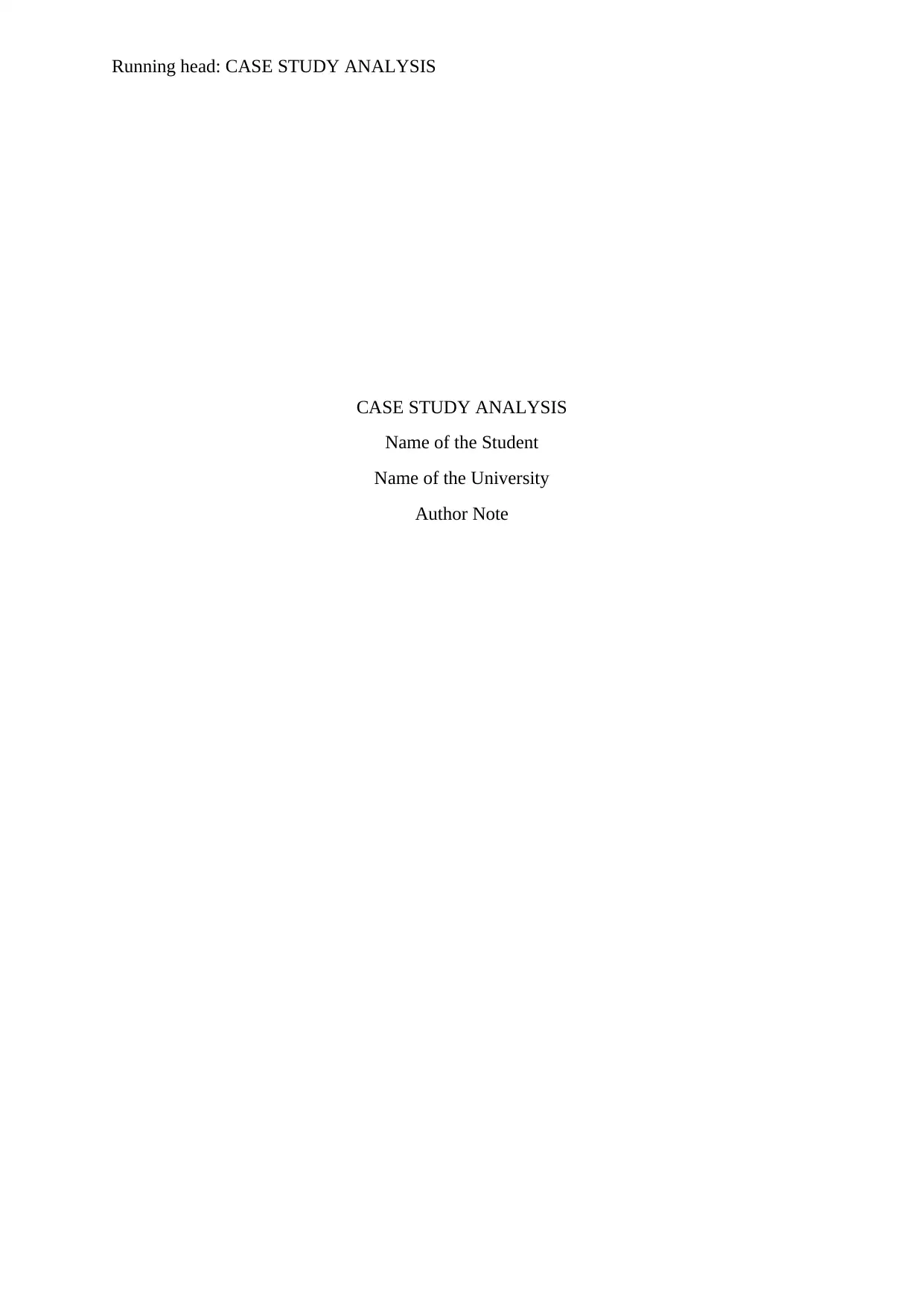
Running head: CASE STUDY ANALYSIS
CASE STUDY ANALYSIS
Name of the Student
Name of the University
Author Note
CASE STUDY ANALYSIS
Name of the Student
Name of the University
Author Note
Paraphrase This Document
Need a fresh take? Get an instant paraphrase of this document with our AI Paraphraser
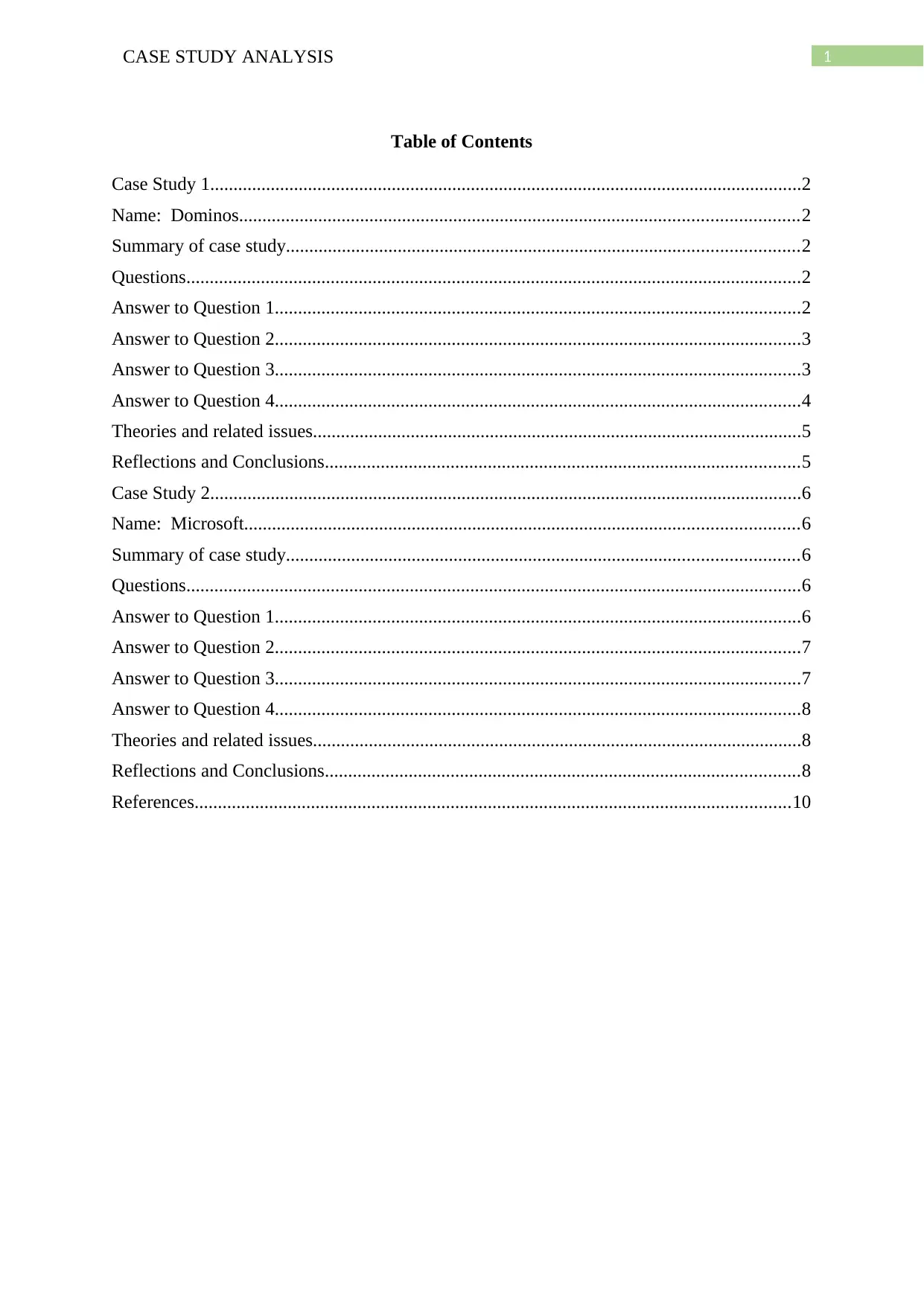
1CASE STUDY ANALYSIS
Table of Contents
Case Study 1...............................................................................................................................2
Name: Dominos........................................................................................................................2
Summary of case study..............................................................................................................2
Questions....................................................................................................................................2
Answer to Question 1.................................................................................................................2
Answer to Question 2.................................................................................................................3
Answer to Question 3.................................................................................................................3
Answer to Question 4.................................................................................................................4
Theories and related issues.........................................................................................................5
Reflections and Conclusions......................................................................................................5
Case Study 2...............................................................................................................................6
Name: Microsoft.......................................................................................................................6
Summary of case study..............................................................................................................6
Questions....................................................................................................................................6
Answer to Question 1.................................................................................................................6
Answer to Question 2.................................................................................................................7
Answer to Question 3.................................................................................................................7
Answer to Question 4.................................................................................................................8
Theories and related issues.........................................................................................................8
Reflections and Conclusions......................................................................................................8
References................................................................................................................................10
Table of Contents
Case Study 1...............................................................................................................................2
Name: Dominos........................................................................................................................2
Summary of case study..............................................................................................................2
Questions....................................................................................................................................2
Answer to Question 1.................................................................................................................2
Answer to Question 2.................................................................................................................3
Answer to Question 3.................................................................................................................3
Answer to Question 4.................................................................................................................4
Theories and related issues.........................................................................................................5
Reflections and Conclusions......................................................................................................5
Case Study 2...............................................................................................................................6
Name: Microsoft.......................................................................................................................6
Summary of case study..............................................................................................................6
Questions....................................................................................................................................6
Answer to Question 1.................................................................................................................6
Answer to Question 2.................................................................................................................7
Answer to Question 3.................................................................................................................7
Answer to Question 4.................................................................................................................8
Theories and related issues.........................................................................................................8
Reflections and Conclusions......................................................................................................8
References................................................................................................................................10
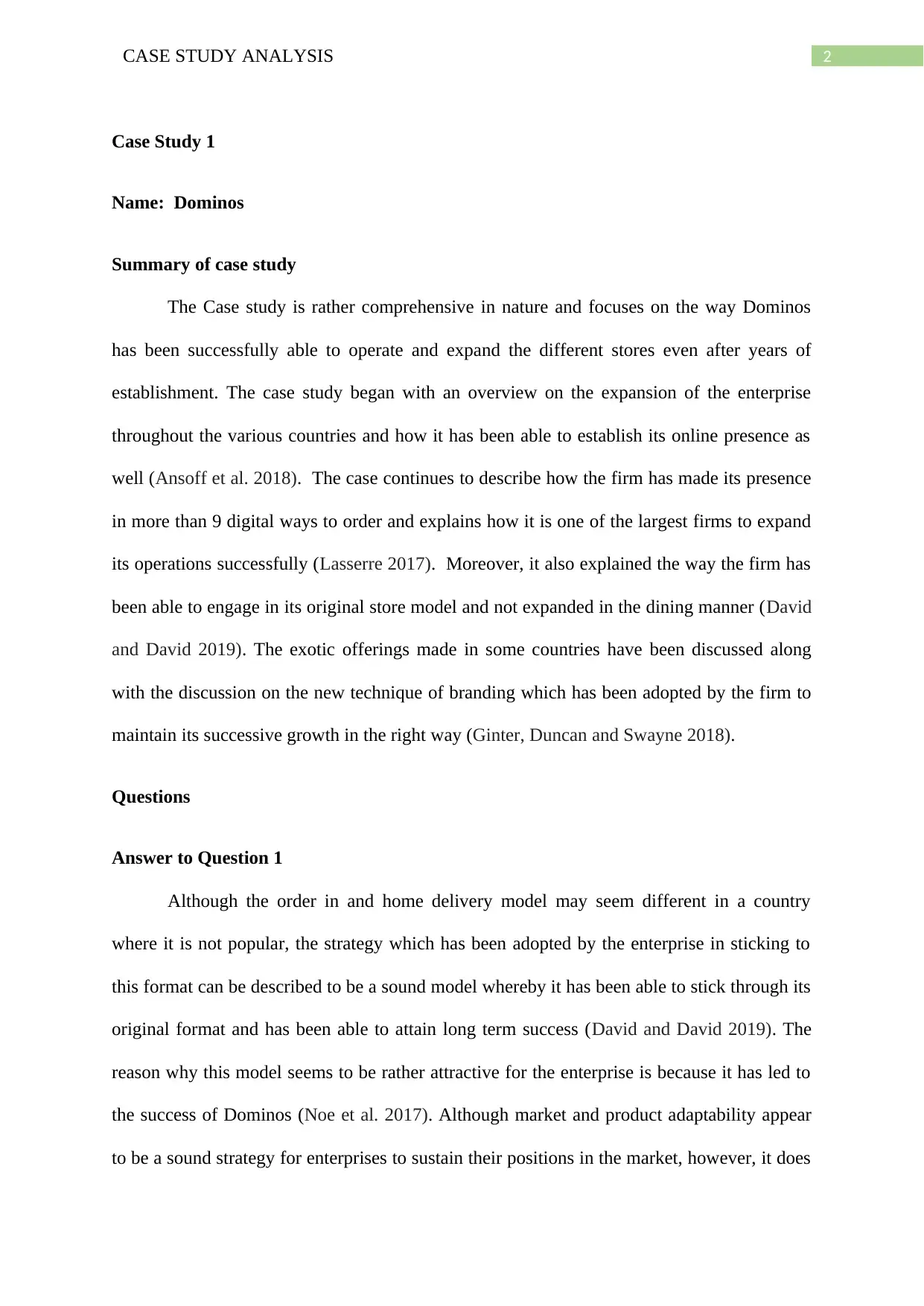
2CASE STUDY ANALYSIS
Case Study 1
Name: Dominos
Summary of case study
The Case study is rather comprehensive in nature and focuses on the way Dominos
has been successfully able to operate and expand the different stores even after years of
establishment. The case study began with an overview on the expansion of the enterprise
throughout the various countries and how it has been able to establish its online presence as
well (Ansoff et al. 2018). The case continues to describe how the firm has made its presence
in more than 9 digital ways to order and explains how it is one of the largest firms to expand
its operations successfully (Lasserre 2017). Moreover, it also explained the way the firm has
been able to engage in its original store model and not expanded in the dining manner (David
and David 2019). The exotic offerings made in some countries have been discussed along
with the discussion on the new technique of branding which has been adopted by the firm to
maintain its successive growth in the right way (Ginter, Duncan and Swayne 2018).
Questions
Answer to Question 1
Although the order in and home delivery model may seem different in a country
where it is not popular, the strategy which has been adopted by the enterprise in sticking to
this format can be described to be a sound model whereby it has been able to stick through its
original format and has been able to attain long term success (David and David 2019). The
reason why this model seems to be rather attractive for the enterprise is because it has led to
the success of Dominos (Noe et al. 2017). Although market and product adaptability appear
to be a sound strategy for enterprises to sustain their positions in the market, however, it does
Case Study 1
Name: Dominos
Summary of case study
The Case study is rather comprehensive in nature and focuses on the way Dominos
has been successfully able to operate and expand the different stores even after years of
establishment. The case study began with an overview on the expansion of the enterprise
throughout the various countries and how it has been able to establish its online presence as
well (Ansoff et al. 2018). The case continues to describe how the firm has made its presence
in more than 9 digital ways to order and explains how it is one of the largest firms to expand
its operations successfully (Lasserre 2017). Moreover, it also explained the way the firm has
been able to engage in its original store model and not expanded in the dining manner (David
and David 2019). The exotic offerings made in some countries have been discussed along
with the discussion on the new technique of branding which has been adopted by the firm to
maintain its successive growth in the right way (Ginter, Duncan and Swayne 2018).
Questions
Answer to Question 1
Although the order in and home delivery model may seem different in a country
where it is not popular, the strategy which has been adopted by the enterprise in sticking to
this format can be described to be a sound model whereby it has been able to stick through its
original format and has been able to attain long term success (David and David 2019). The
reason why this model seems to be rather attractive for the enterprise is because it has led to
the success of Dominos (Noe et al. 2017). Although market and product adaptability appear
to be a sound strategy for enterprises to sustain their positions in the market, however, it does
⊘ This is a preview!⊘
Do you want full access?
Subscribe today to unlock all pages.

Trusted by 1+ million students worldwide
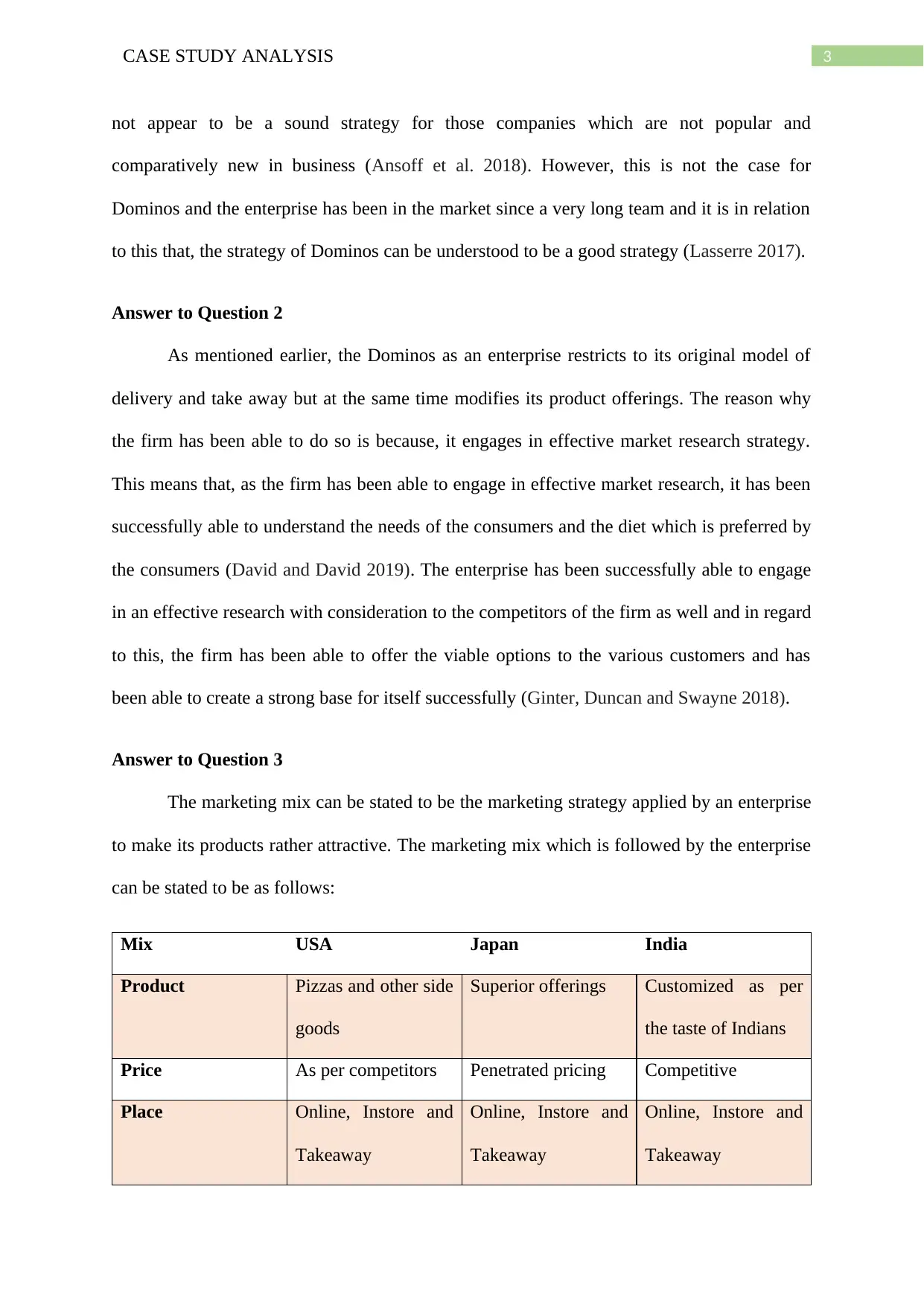
3CASE STUDY ANALYSIS
not appear to be a sound strategy for those companies which are not popular and
comparatively new in business (Ansoff et al. 2018). However, this is not the case for
Dominos and the enterprise has been in the market since a very long team and it is in relation
to this that, the strategy of Dominos can be understood to be a good strategy (Lasserre 2017).
Answer to Question 2
As mentioned earlier, the Dominos as an enterprise restricts to its original model of
delivery and take away but at the same time modifies its product offerings. The reason why
the firm has been able to do so is because, it engages in effective market research strategy.
This means that, as the firm has been able to engage in effective market research, it has been
successfully able to understand the needs of the consumers and the diet which is preferred by
the consumers (David and David 2019). The enterprise has been successfully able to engage
in an effective research with consideration to the competitors of the firm as well and in regard
to this, the firm has been able to offer the viable options to the various customers and has
been able to create a strong base for itself successfully (Ginter, Duncan and Swayne 2018).
Answer to Question 3
The marketing mix can be stated to be the marketing strategy applied by an enterprise
to make its products rather attractive. The marketing mix which is followed by the enterprise
can be stated to be as follows:
Mix USA Japan India
Product Pizzas and other side
goods
Superior offerings Customized as per
the taste of Indians
Price As per competitors Penetrated pricing Competitive
Place Online, Instore and
Takeaway
Online, Instore and
Takeaway
Online, Instore and
Takeaway
not appear to be a sound strategy for those companies which are not popular and
comparatively new in business (Ansoff et al. 2018). However, this is not the case for
Dominos and the enterprise has been in the market since a very long team and it is in relation
to this that, the strategy of Dominos can be understood to be a good strategy (Lasserre 2017).
Answer to Question 2
As mentioned earlier, the Dominos as an enterprise restricts to its original model of
delivery and take away but at the same time modifies its product offerings. The reason why
the firm has been able to do so is because, it engages in effective market research strategy.
This means that, as the firm has been able to engage in effective market research, it has been
successfully able to understand the needs of the consumers and the diet which is preferred by
the consumers (David and David 2019). The enterprise has been successfully able to engage
in an effective research with consideration to the competitors of the firm as well and in regard
to this, the firm has been able to offer the viable options to the various customers and has
been able to create a strong base for itself successfully (Ginter, Duncan and Swayne 2018).
Answer to Question 3
The marketing mix can be stated to be the marketing strategy applied by an enterprise
to make its products rather attractive. The marketing mix which is followed by the enterprise
can be stated to be as follows:
Mix USA Japan India
Product Pizzas and other side
goods
Superior offerings Customized as per
the taste of Indians
Price As per competitors Penetrated pricing Competitive
Place Online, Instore and
Takeaway
Online, Instore and
Takeaway
Online, Instore and
Takeaway
Paraphrase This Document
Need a fresh take? Get an instant paraphrase of this document with our AI Paraphraser
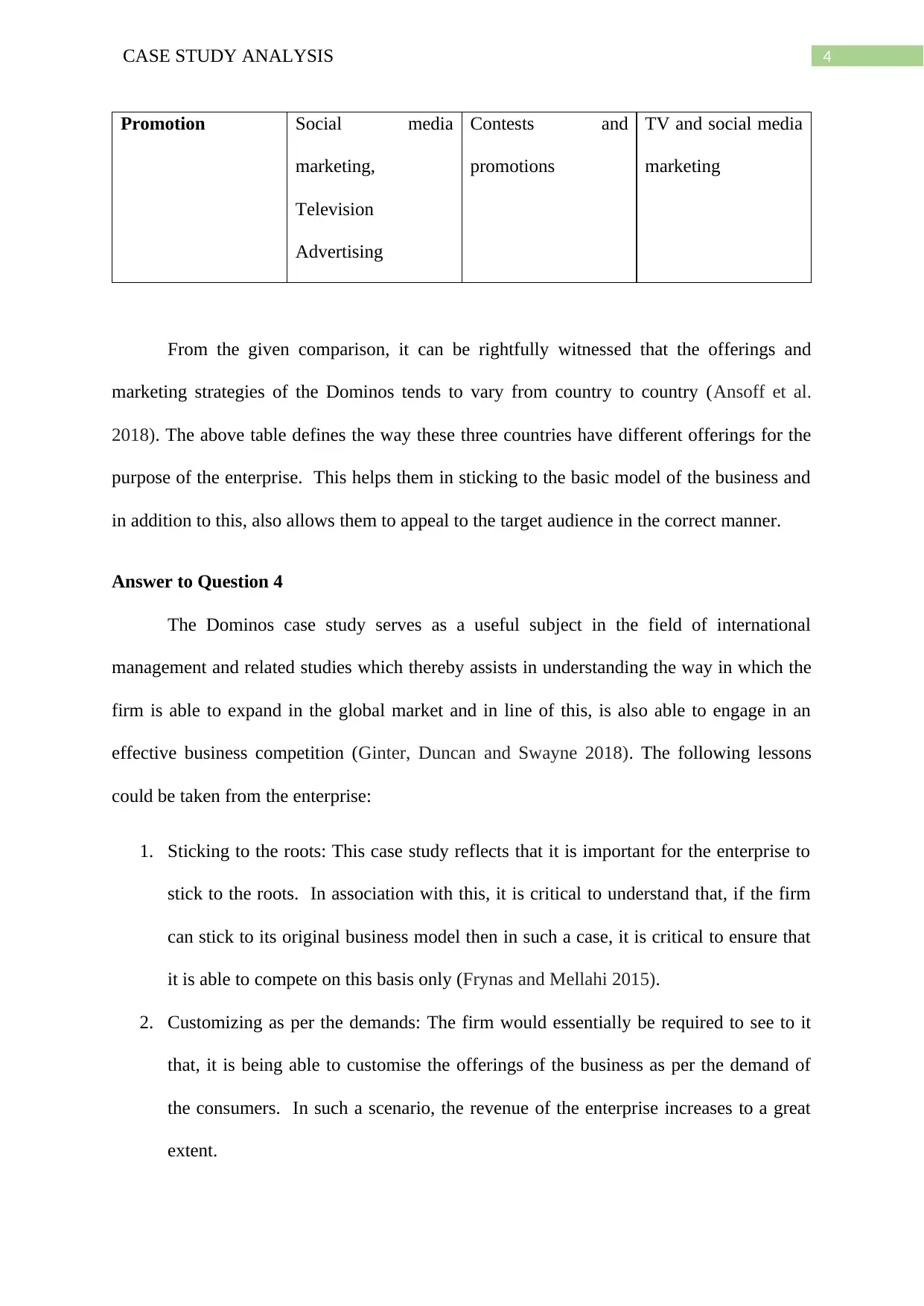
4CASE STUDY ANALYSIS
Promotion Social media
marketing,
Television
Advertising
Contests and
promotions
TV and social media
marketing
From the given comparison, it can be rightfully witnessed that the offerings and
marketing strategies of the Dominos tends to vary from country to country (Ansoff et al.
2018). The above table defines the way these three countries have different offerings for the
purpose of the enterprise. This helps them in sticking to the basic model of the business and
in addition to this, also allows them to appeal to the target audience in the correct manner.
Answer to Question 4
The Dominos case study serves as a useful subject in the field of international
management and related studies which thereby assists in understanding the way in which the
firm is able to expand in the global market and in line of this, is also able to engage in an
effective business competition (Ginter, Duncan and Swayne 2018). The following lessons
could be taken from the enterprise:
1. Sticking to the roots: This case study reflects that it is important for the enterprise to
stick to the roots. In association with this, it is critical to understand that, if the firm
can stick to its original business model then in such a case, it is critical to ensure that
it is able to compete on this basis only (Frynas and Mellahi 2015).
2. Customizing as per the demands: The firm would essentially be required to see to it
that, it is being able to customise the offerings of the business as per the demand of
the consumers. In such a scenario, the revenue of the enterprise increases to a great
extent.
Promotion Social media
marketing,
Television
Advertising
Contests and
promotions
TV and social media
marketing
From the given comparison, it can be rightfully witnessed that the offerings and
marketing strategies of the Dominos tends to vary from country to country (Ansoff et al.
2018). The above table defines the way these three countries have different offerings for the
purpose of the enterprise. This helps them in sticking to the basic model of the business and
in addition to this, also allows them to appeal to the target audience in the correct manner.
Answer to Question 4
The Dominos case study serves as a useful subject in the field of international
management and related studies which thereby assists in understanding the way in which the
firm is able to expand in the global market and in line of this, is also able to engage in an
effective business competition (Ginter, Duncan and Swayne 2018). The following lessons
could be taken from the enterprise:
1. Sticking to the roots: This case study reflects that it is important for the enterprise to
stick to the roots. In association with this, it is critical to understand that, if the firm
can stick to its original business model then in such a case, it is critical to ensure that
it is able to compete on this basis only (Frynas and Mellahi 2015).
2. Customizing as per the demands: The firm would essentially be required to see to it
that, it is being able to customise the offerings of the business as per the demand of
the consumers. In such a scenario, the revenue of the enterprise increases to a great
extent.
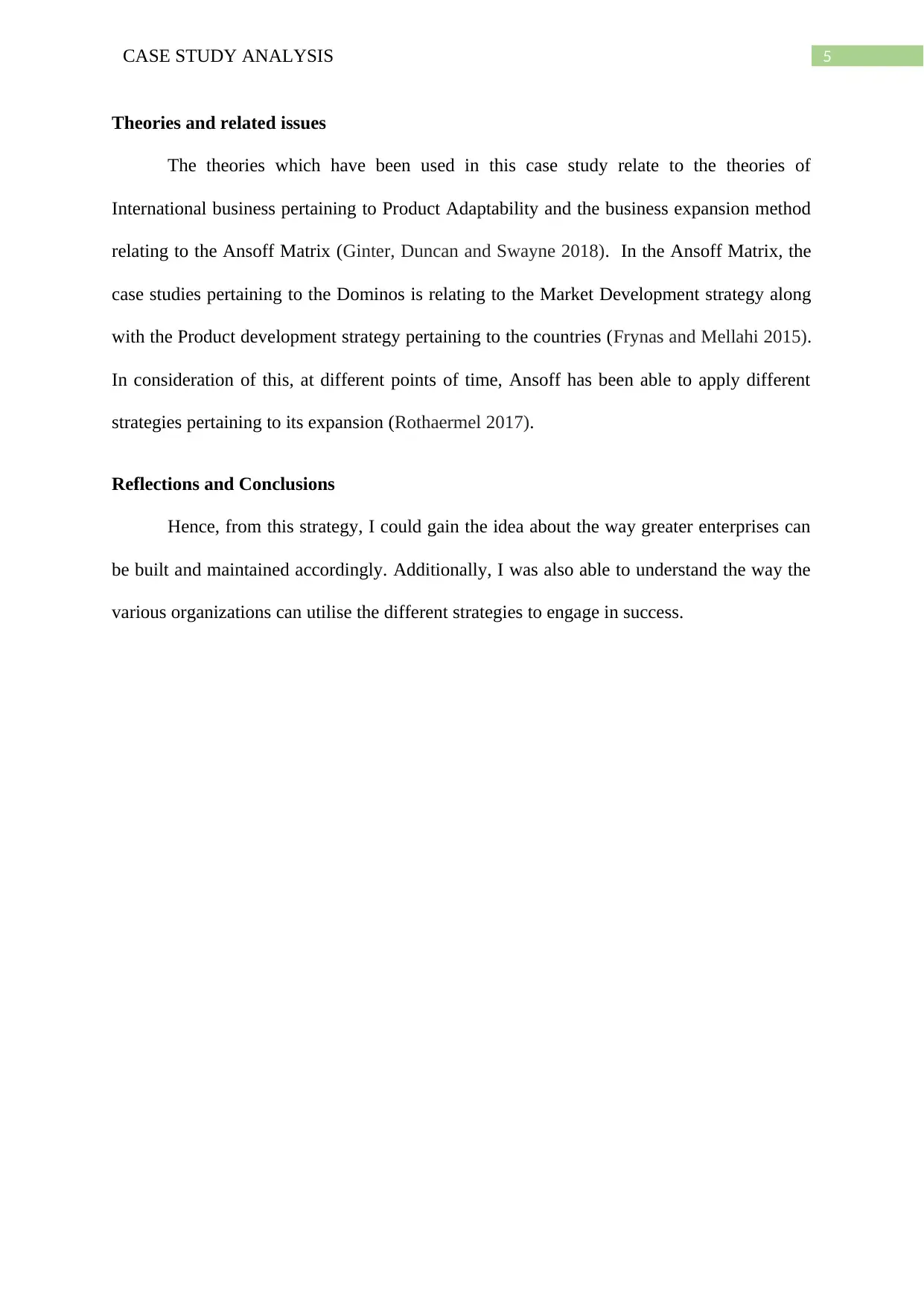
5CASE STUDY ANALYSIS
Theories and related issues
The theories which have been used in this case study relate to the theories of
International business pertaining to Product Adaptability and the business expansion method
relating to the Ansoff Matrix (Ginter, Duncan and Swayne 2018). In the Ansoff Matrix, the
case studies pertaining to the Dominos is relating to the Market Development strategy along
with the Product development strategy pertaining to the countries (Frynas and Mellahi 2015).
In consideration of this, at different points of time, Ansoff has been able to apply different
strategies pertaining to its expansion (Rothaermel 2017).
Reflections and Conclusions
Hence, from this strategy, I could gain the idea about the way greater enterprises can
be built and maintained accordingly. Additionally, I was also able to understand the way the
various organizations can utilise the different strategies to engage in success.
Theories and related issues
The theories which have been used in this case study relate to the theories of
International business pertaining to Product Adaptability and the business expansion method
relating to the Ansoff Matrix (Ginter, Duncan and Swayne 2018). In the Ansoff Matrix, the
case studies pertaining to the Dominos is relating to the Market Development strategy along
with the Product development strategy pertaining to the countries (Frynas and Mellahi 2015).
In consideration of this, at different points of time, Ansoff has been able to apply different
strategies pertaining to its expansion (Rothaermel 2017).
Reflections and Conclusions
Hence, from this strategy, I could gain the idea about the way greater enterprises can
be built and maintained accordingly. Additionally, I was also able to understand the way the
various organizations can utilise the different strategies to engage in success.
⊘ This is a preview!⊘
Do you want full access?
Subscribe today to unlock all pages.

Trusted by 1+ million students worldwide
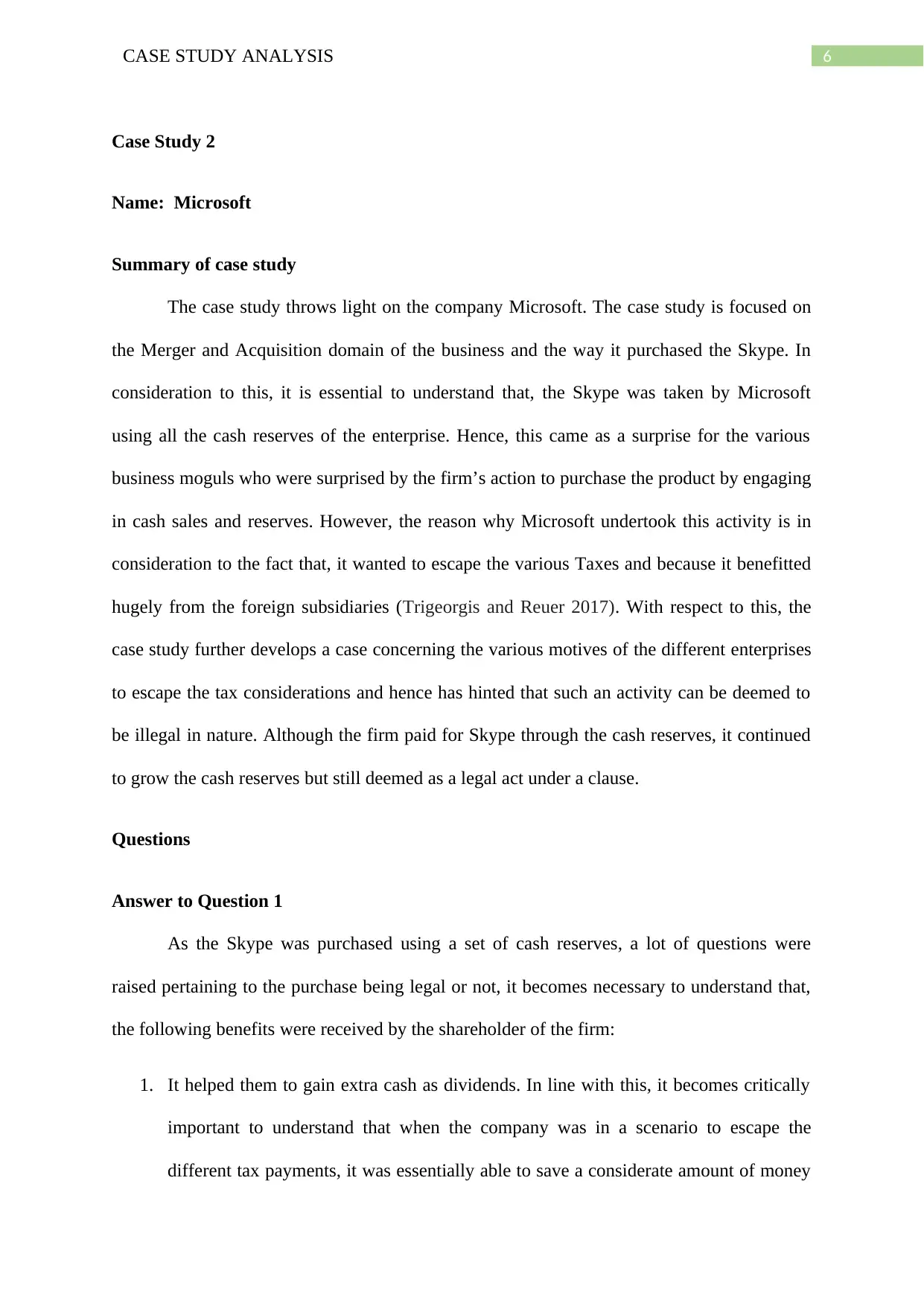
6CASE STUDY ANALYSIS
Case Study 2
Name: Microsoft
Summary of case study
The case study throws light on the company Microsoft. The case study is focused on
the Merger and Acquisition domain of the business and the way it purchased the Skype. In
consideration to this, it is essential to understand that, the Skype was taken by Microsoft
using all the cash reserves of the enterprise. Hence, this came as a surprise for the various
business moguls who were surprised by the firm’s action to purchase the product by engaging
in cash sales and reserves. However, the reason why Microsoft undertook this activity is in
consideration to the fact that, it wanted to escape the various Taxes and because it benefitted
hugely from the foreign subsidiaries (Trigeorgis and Reuer 2017). With respect to this, the
case study further develops a case concerning the various motives of the different enterprises
to escape the tax considerations and hence has hinted that such an activity can be deemed to
be illegal in nature. Although the firm paid for Skype through the cash reserves, it continued
to grow the cash reserves but still deemed as a legal act under a clause.
Questions
Answer to Question 1
As the Skype was purchased using a set of cash reserves, a lot of questions were
raised pertaining to the purchase being legal or not, it becomes necessary to understand that,
the following benefits were received by the shareholder of the firm:
1. It helped them to gain extra cash as dividends. In line with this, it becomes critically
important to understand that when the company was in a scenario to escape the
different tax payments, it was essentially able to save a considerate amount of money
Case Study 2
Name: Microsoft
Summary of case study
The case study throws light on the company Microsoft. The case study is focused on
the Merger and Acquisition domain of the business and the way it purchased the Skype. In
consideration to this, it is essential to understand that, the Skype was taken by Microsoft
using all the cash reserves of the enterprise. Hence, this came as a surprise for the various
business moguls who were surprised by the firm’s action to purchase the product by engaging
in cash sales and reserves. However, the reason why Microsoft undertook this activity is in
consideration to the fact that, it wanted to escape the various Taxes and because it benefitted
hugely from the foreign subsidiaries (Trigeorgis and Reuer 2017). With respect to this, the
case study further develops a case concerning the various motives of the different enterprises
to escape the tax considerations and hence has hinted that such an activity can be deemed to
be illegal in nature. Although the firm paid for Skype through the cash reserves, it continued
to grow the cash reserves but still deemed as a legal act under a clause.
Questions
Answer to Question 1
As the Skype was purchased using a set of cash reserves, a lot of questions were
raised pertaining to the purchase being legal or not, it becomes necessary to understand that,
the following benefits were received by the shareholder of the firm:
1. It helped them to gain extra cash as dividends. In line with this, it becomes critically
important to understand that when the company was in a scenario to escape the
different tax payments, it was essentially able to save a considerate amount of money
Paraphrase This Document
Need a fresh take? Get an instant paraphrase of this document with our AI Paraphraser
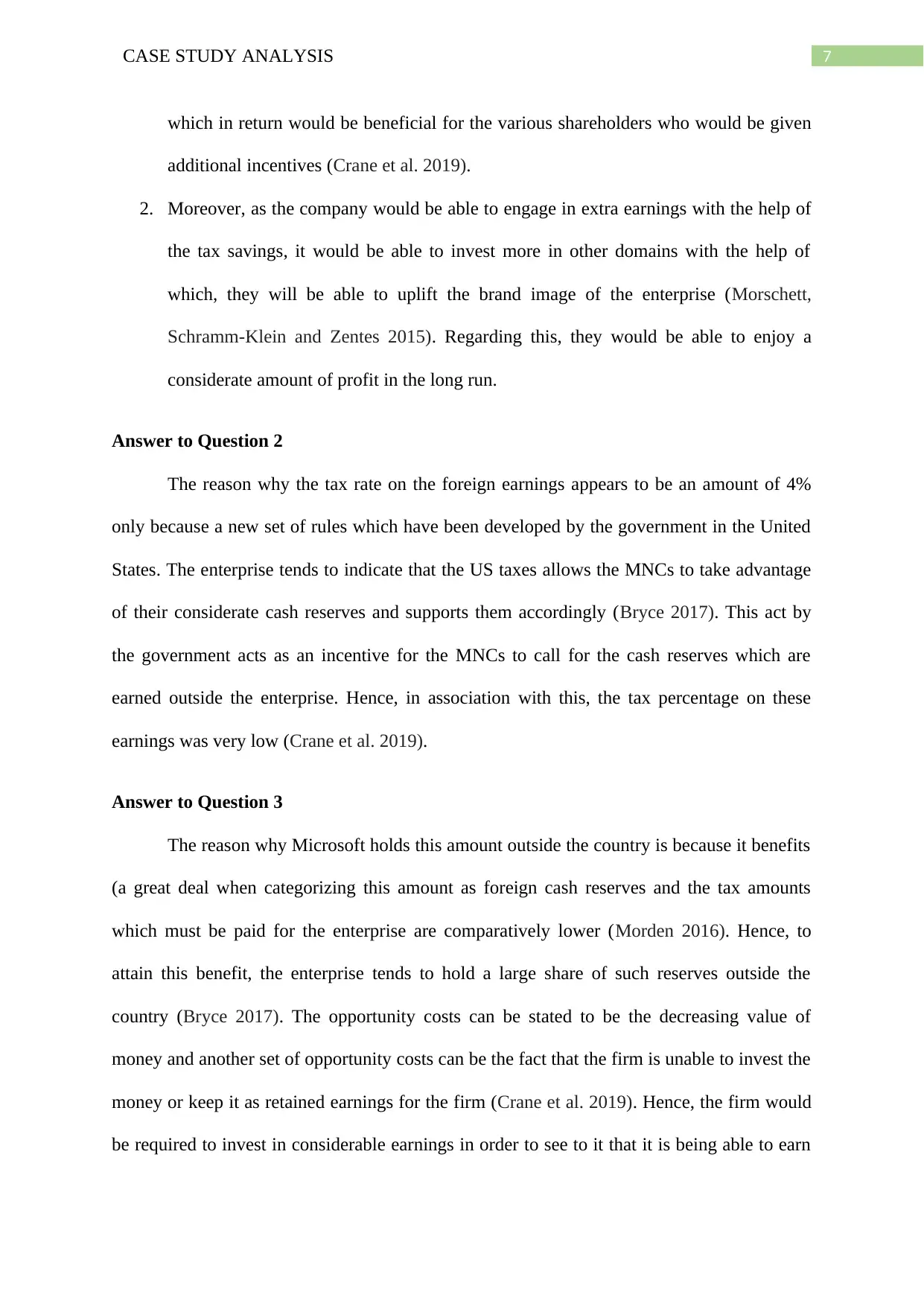
7CASE STUDY ANALYSIS
which in return would be beneficial for the various shareholders who would be given
additional incentives (Crane et al. 2019).
2. Moreover, as the company would be able to engage in extra earnings with the help of
the tax savings, it would be able to invest more in other domains with the help of
which, they will be able to uplift the brand image of the enterprise (Morschett,
Schramm-Klein and Zentes 2015). Regarding this, they would be able to enjoy a
considerate amount of profit in the long run.
Answer to Question 2
The reason why the tax rate on the foreign earnings appears to be an amount of 4%
only because a new set of rules which have been developed by the government in the United
States. The enterprise tends to indicate that the US taxes allows the MNCs to take advantage
of their considerate cash reserves and supports them accordingly (Bryce 2017). This act by
the government acts as an incentive for the MNCs to call for the cash reserves which are
earned outside the enterprise. Hence, in association with this, the tax percentage on these
earnings was very low (Crane et al. 2019).
Answer to Question 3
The reason why Microsoft holds this amount outside the country is because it benefits
(a great deal when categorizing this amount as foreign cash reserves and the tax amounts
which must be paid for the enterprise are comparatively lower (Morden 2016). Hence, to
attain this benefit, the enterprise tends to hold a large share of such reserves outside the
country (Bryce 2017). The opportunity costs can be stated to be the decreasing value of
money and another set of opportunity costs can be the fact that the firm is unable to invest the
money or keep it as retained earnings for the firm (Crane et al. 2019). Hence, the firm would
be required to invest in considerable earnings in order to see to it that it is being able to earn
which in return would be beneficial for the various shareholders who would be given
additional incentives (Crane et al. 2019).
2. Moreover, as the company would be able to engage in extra earnings with the help of
the tax savings, it would be able to invest more in other domains with the help of
which, they will be able to uplift the brand image of the enterprise (Morschett,
Schramm-Klein and Zentes 2015). Regarding this, they would be able to enjoy a
considerate amount of profit in the long run.
Answer to Question 2
The reason why the tax rate on the foreign earnings appears to be an amount of 4%
only because a new set of rules which have been developed by the government in the United
States. The enterprise tends to indicate that the US taxes allows the MNCs to take advantage
of their considerate cash reserves and supports them accordingly (Bryce 2017). This act by
the government acts as an incentive for the MNCs to call for the cash reserves which are
earned outside the enterprise. Hence, in association with this, the tax percentage on these
earnings was very low (Crane et al. 2019).
Answer to Question 3
The reason why Microsoft holds this amount outside the country is because it benefits
(a great deal when categorizing this amount as foreign cash reserves and the tax amounts
which must be paid for the enterprise are comparatively lower (Morden 2016). Hence, to
attain this benefit, the enterprise tends to hold a large share of such reserves outside the
country (Bryce 2017). The opportunity costs can be stated to be the decreasing value of
money and another set of opportunity costs can be the fact that the firm is unable to invest the
money or keep it as retained earnings for the firm (Crane et al. 2019). Hence, the firm would
be required to invest in considerable earnings in order to see to it that it is being able to earn
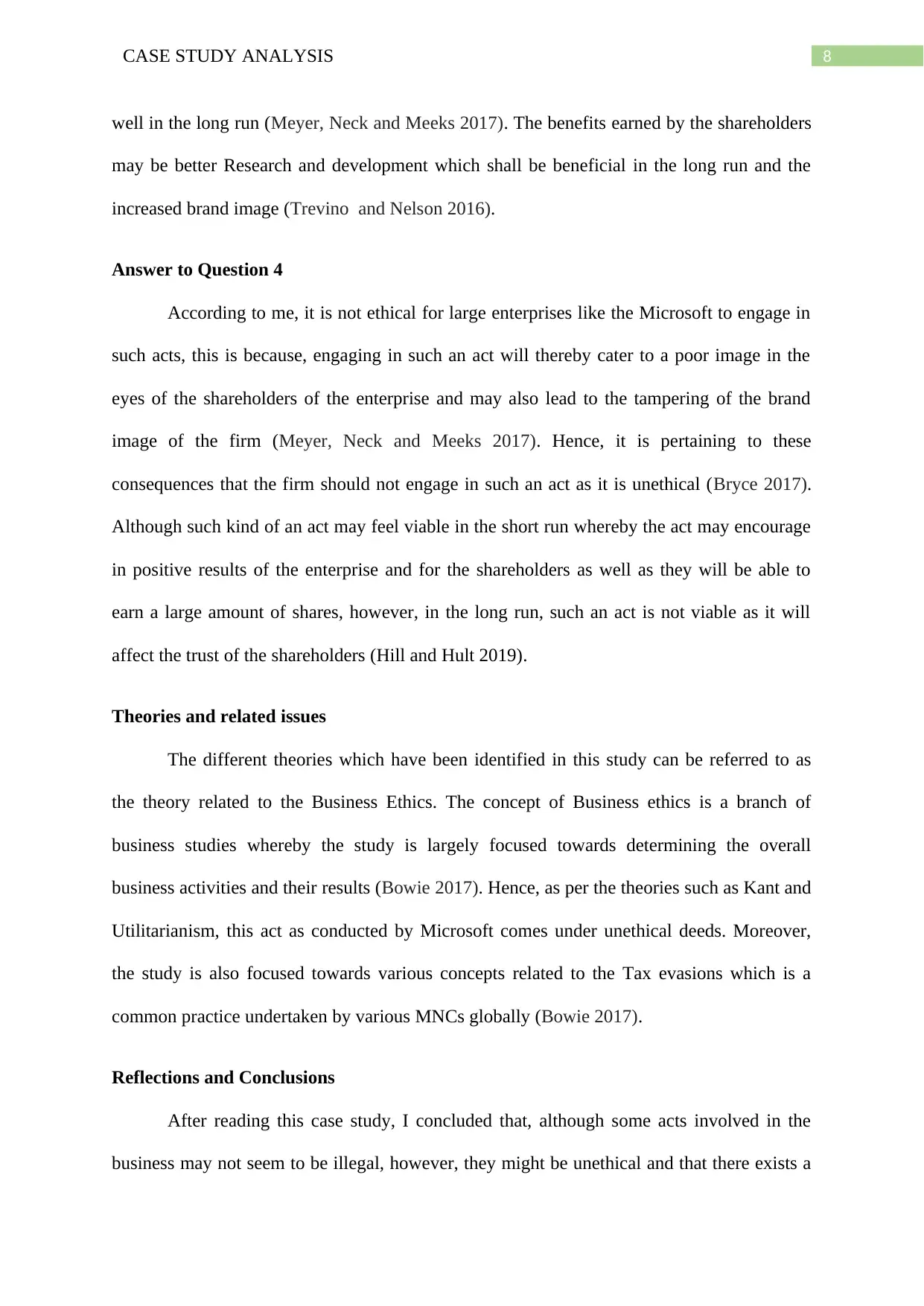
8CASE STUDY ANALYSIS
well in the long run (Meyer, Neck and Meeks 2017). The benefits earned by the shareholders
may be better Research and development which shall be beneficial in the long run and the
increased brand image (Trevino and Nelson 2016).
Answer to Question 4
According to me, it is not ethical for large enterprises like the Microsoft to engage in
such acts, this is because, engaging in such an act will thereby cater to a poor image in the
eyes of the shareholders of the enterprise and may also lead to the tampering of the brand
image of the firm (Meyer, Neck and Meeks 2017). Hence, it is pertaining to these
consequences that the firm should not engage in such an act as it is unethical (Bryce 2017).
Although such kind of an act may feel viable in the short run whereby the act may encourage
in positive results of the enterprise and for the shareholders as well as they will be able to
earn a large amount of shares, however, in the long run, such an act is not viable as it will
affect the trust of the shareholders (Hill and Hult 2019).
Theories and related issues
The different theories which have been identified in this study can be referred to as
the theory related to the Business Ethics. The concept of Business ethics is a branch of
business studies whereby the study is largely focused towards determining the overall
business activities and their results (Bowie 2017). Hence, as per the theories such as Kant and
Utilitarianism, this act as conducted by Microsoft comes under unethical deeds. Moreover,
the study is also focused towards various concepts related to the Tax evasions which is a
common practice undertaken by various MNCs globally (Bowie 2017).
Reflections and Conclusions
After reading this case study, I concluded that, although some acts involved in the
business may not seem to be illegal, however, they might be unethical and that there exists a
well in the long run (Meyer, Neck and Meeks 2017). The benefits earned by the shareholders
may be better Research and development which shall be beneficial in the long run and the
increased brand image (Trevino and Nelson 2016).
Answer to Question 4
According to me, it is not ethical for large enterprises like the Microsoft to engage in
such acts, this is because, engaging in such an act will thereby cater to a poor image in the
eyes of the shareholders of the enterprise and may also lead to the tampering of the brand
image of the firm (Meyer, Neck and Meeks 2017). Hence, it is pertaining to these
consequences that the firm should not engage in such an act as it is unethical (Bryce 2017).
Although such kind of an act may feel viable in the short run whereby the act may encourage
in positive results of the enterprise and for the shareholders as well as they will be able to
earn a large amount of shares, however, in the long run, such an act is not viable as it will
affect the trust of the shareholders (Hill and Hult 2019).
Theories and related issues
The different theories which have been identified in this study can be referred to as
the theory related to the Business Ethics. The concept of Business ethics is a branch of
business studies whereby the study is largely focused towards determining the overall
business activities and their results (Bowie 2017). Hence, as per the theories such as Kant and
Utilitarianism, this act as conducted by Microsoft comes under unethical deeds. Moreover,
the study is also focused towards various concepts related to the Tax evasions which is a
common practice undertaken by various MNCs globally (Bowie 2017).
Reflections and Conclusions
After reading this case study, I concluded that, although some acts involved in the
business may not seem to be illegal, however, they might be unethical and that there exists a
⊘ This is a preview!⊘
Do you want full access?
Subscribe today to unlock all pages.

Trusted by 1+ million students worldwide

9CASE STUDY ANALYSIS
fine line between illegal and unethical as well. Hence, this case study assisted in broadening
my perspective regarding the overall study and its related operations. Through this case
study, I was also able to gain an idea about the way large MNCs generally function and the
ways in which the theories of Business ethics govern the acts of the enterprises.
fine line between illegal and unethical as well. Hence, this case study assisted in broadening
my perspective regarding the overall study and its related operations. Through this case
study, I was also able to gain an idea about the way large MNCs generally function and the
ways in which the theories of Business ethics govern the acts of the enterprises.
Paraphrase This Document
Need a fresh take? Get an instant paraphrase of this document with our AI Paraphraser
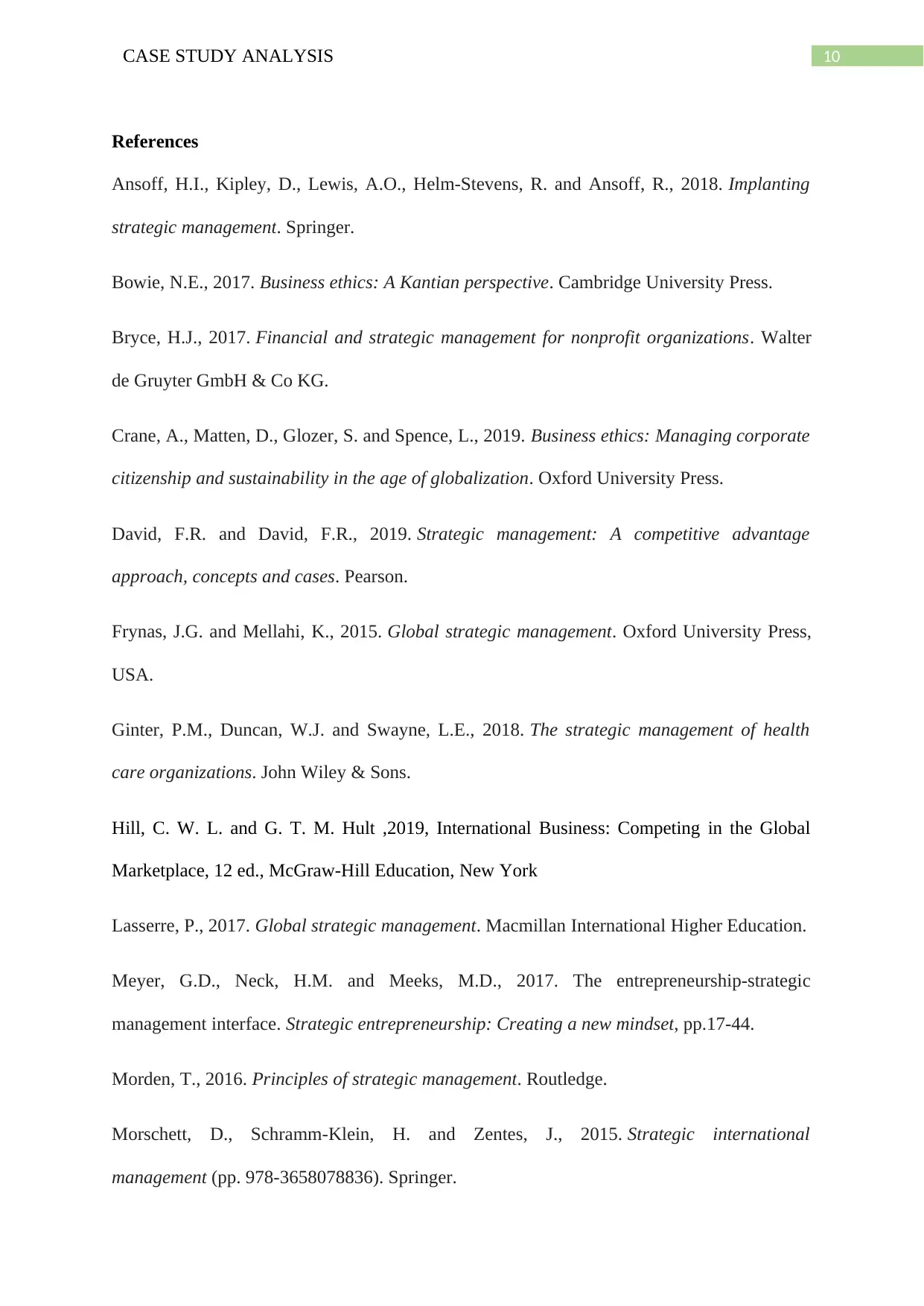
10CASE STUDY ANALYSIS
References
Ansoff, H.I., Kipley, D., Lewis, A.O., Helm-Stevens, R. and Ansoff, R., 2018. Implanting
strategic management. Springer.
Bowie, N.E., 2017. Business ethics: A Kantian perspective. Cambridge University Press.
Bryce, H.J., 2017. Financial and strategic management for nonprofit organizations. Walter
de Gruyter GmbH & Co KG.
Crane, A., Matten, D., Glozer, S. and Spence, L., 2019. Business ethics: Managing corporate
citizenship and sustainability in the age of globalization. Oxford University Press.
David, F.R. and David, F.R., 2019. Strategic management: A competitive advantage
approach, concepts and cases. Pearson.
Frynas, J.G. and Mellahi, K., 2015. Global strategic management. Oxford University Press,
USA.
Ginter, P.M., Duncan, W.J. and Swayne, L.E., 2018. The strategic management of health
care organizations. John Wiley & Sons.
Hill, C. W. L. and G. T. M. Hult ,2019, International Business: Competing in the Global
Marketplace, 12 ed., McGraw-Hill Education, New York
Lasserre, P., 2017. Global strategic management. Macmillan International Higher Education.
Meyer, G.D., Neck, H.M. and Meeks, M.D., 2017. The entrepreneurship‐strategic
management interface. Strategic entrepreneurship: Creating a new mindset, pp.17-44.
Morden, T., 2016. Principles of strategic management. Routledge.
Morschett, D., Schramm-Klein, H. and Zentes, J., 2015. Strategic international
management (pp. 978-3658078836). Springer.
References
Ansoff, H.I., Kipley, D., Lewis, A.O., Helm-Stevens, R. and Ansoff, R., 2018. Implanting
strategic management. Springer.
Bowie, N.E., 2017. Business ethics: A Kantian perspective. Cambridge University Press.
Bryce, H.J., 2017. Financial and strategic management for nonprofit organizations. Walter
de Gruyter GmbH & Co KG.
Crane, A., Matten, D., Glozer, S. and Spence, L., 2019. Business ethics: Managing corporate
citizenship and sustainability in the age of globalization. Oxford University Press.
David, F.R. and David, F.R., 2019. Strategic management: A competitive advantage
approach, concepts and cases. Pearson.
Frynas, J.G. and Mellahi, K., 2015. Global strategic management. Oxford University Press,
USA.
Ginter, P.M., Duncan, W.J. and Swayne, L.E., 2018. The strategic management of health
care organizations. John Wiley & Sons.
Hill, C. W. L. and G. T. M. Hult ,2019, International Business: Competing in the Global
Marketplace, 12 ed., McGraw-Hill Education, New York
Lasserre, P., 2017. Global strategic management. Macmillan International Higher Education.
Meyer, G.D., Neck, H.M. and Meeks, M.D., 2017. The entrepreneurship‐strategic
management interface. Strategic entrepreneurship: Creating a new mindset, pp.17-44.
Morden, T., 2016. Principles of strategic management. Routledge.
Morschett, D., Schramm-Klein, H. and Zentes, J., 2015. Strategic international
management (pp. 978-3658078836). Springer.
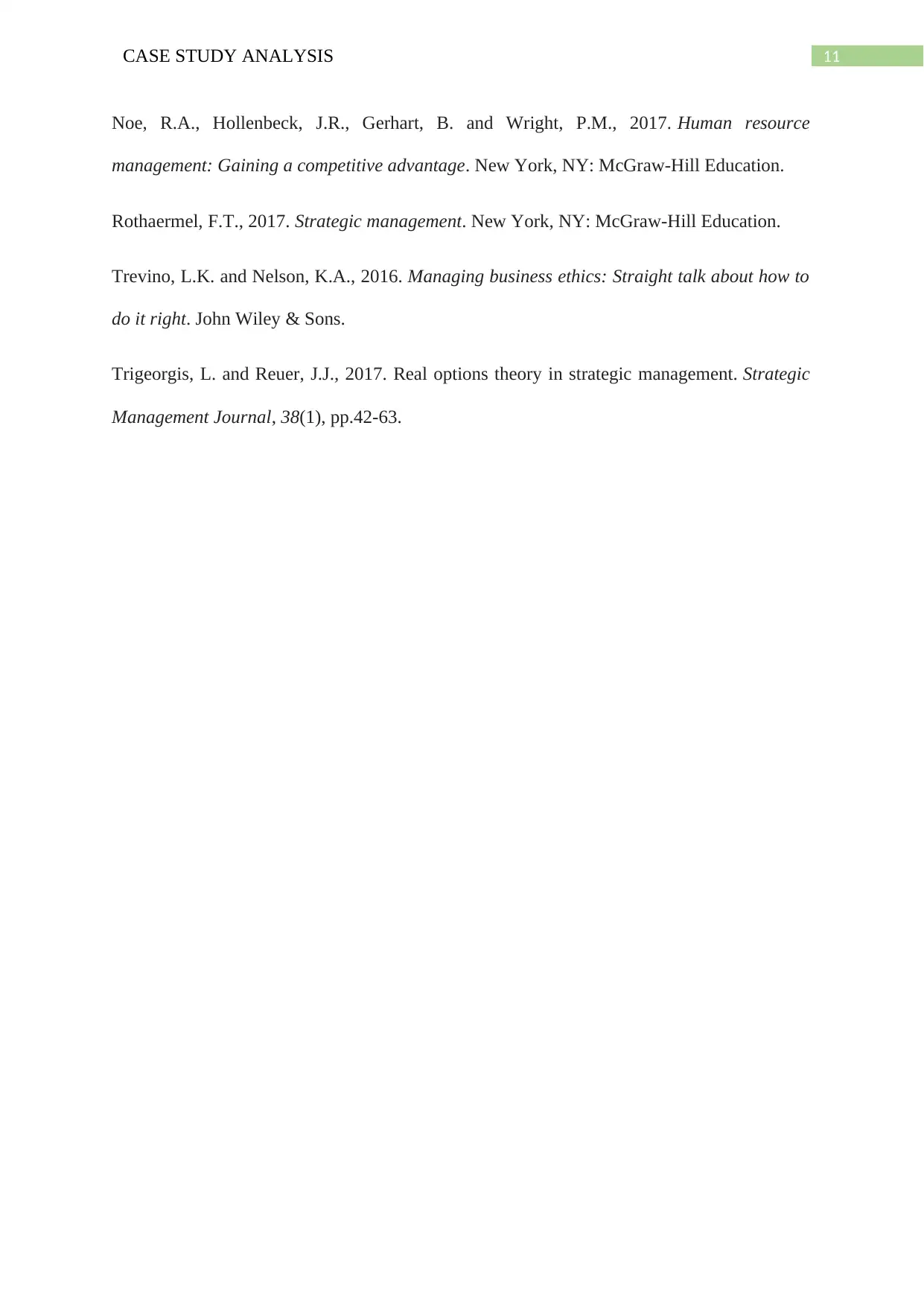
11CASE STUDY ANALYSIS
Noe, R.A., Hollenbeck, J.R., Gerhart, B. and Wright, P.M., 2017. Human resource
management: Gaining a competitive advantage. New York, NY: McGraw-Hill Education.
Rothaermel, F.T., 2017. Strategic management. New York, NY: McGraw-Hill Education.
Trevino, L.K. and Nelson, K.A., 2016. Managing business ethics: Straight talk about how to
do it right. John Wiley & Sons.
Trigeorgis, L. and Reuer, J.J., 2017. Real options theory in strategic management. Strategic
Management Journal, 38(1), pp.42-63.
Noe, R.A., Hollenbeck, J.R., Gerhart, B. and Wright, P.M., 2017. Human resource
management: Gaining a competitive advantage. New York, NY: McGraw-Hill Education.
Rothaermel, F.T., 2017. Strategic management. New York, NY: McGraw-Hill Education.
Trevino, L.K. and Nelson, K.A., 2016. Managing business ethics: Straight talk about how to
do it right. John Wiley & Sons.
Trigeorgis, L. and Reuer, J.J., 2017. Real options theory in strategic management. Strategic
Management Journal, 38(1), pp.42-63.
⊘ This is a preview!⊘
Do you want full access?
Subscribe today to unlock all pages.

Trusted by 1+ million students worldwide
1 out of 12
Related Documents
Your All-in-One AI-Powered Toolkit for Academic Success.
+13062052269
info@desklib.com
Available 24*7 on WhatsApp / Email
![[object Object]](/_next/static/media/star-bottom.7253800d.svg)
Unlock your academic potential
Copyright © 2020–2025 A2Z Services. All Rights Reserved. Developed and managed by ZUCOL.





